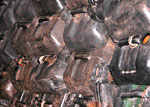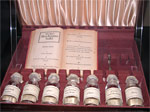Topic four: The present past: the use of art in the marking of the bicentenary
The marking of the bicentenary of the abolition of the slave trade in museums and galleries throughout Britain has created a number of points of discussion and debate regarding the representation of a traumatic history. One of the key features of this has been the use of contemporary art in museums and galleries, as installations, exhibitions and 'interventions'.
This use of modern art has supplemented and on some occasions even replaced traditional exhibition formats. This marks a radical departure for many museums, as the role of institutions representing the past through artefacts has been so enshrined in practice, that the notion of contemporary artistic representation performing this duty is seen by some as an anathema (anon 2007). The question of the prominence, place and power of contemporary art to communicate to audiences therefore requires critical assessment.
Application of contemporary art
The appearance of modern art within museums has been a key feature of the bicentenary of the abolition of the slave trade. Various institutions have taken the opportunity to buy and commission art to install in their gallery spaces and alongside their exhibitions and panel displays.
Perhaps the most prominent has been the purchase of Romauald Hazoumé's La Bouche de Roi by the British Museum, which was displayed at the museum and several touring venues around Britain during 2007. But this is indicative of a far wider trend in British museums this year. From a local level to a national level, museums have responded overwhelmingly to the 1807 bicentenary through contemporary art.

Detail from 'La Bouche du Roi'
Copyright: Romauald Hazoumé,
Courtesy: October Gallery
Larger image (60KB)
Plymouth Museum and Art Gallery commissioned a number of artists in their exhibition Human Cargo to explore the history and legacy of the transatlantic slave trade. Ipswich Museum in their exhibition, 'Abolition - The Thomas Clarkson Story', have commissioned the artist Anissa-Jane to provide challenging works for the exhibition. These works complement and contradict the exhibition and the history of the abolitionist as they address the history from an alternative perspective.
The International Slavery Museum in Liverpool, during it's opening in August 2007, also placed on display the Freedom sculpture; a work which uses scrap metal found in Port au Prince, Haiti, and which was created by local children and artists with Mario Benjamin.
Interventions
Alongside the prominent displays in museums, modern art has been used to challenge and subvert the messages of other historical works of art. The Uncomfortable Truths display at the Victoria and Albert Museum is an example of this process of 'intervention'. Works by prominent artists such as Fred Wilson and Keith Piper have been placed to interact with portraits of individuals and material objects which have association with the transatlantic slave trade.

Detail from 'Lost Vitrines'
Copyright: Keith Piper, Courtesy: Victoria and Albert Museum, London
Larger image (47KB)
Piper's Lost Vitrines does more than this however by subtly challenging the weight and authority of the museum institution itself. Piper's work, such as 'Miss Mary's Micro-Resistance Tool Kit', which purports to be a historical artefact, instructing the enslaved in how to rebel against their oppressors, plays on the authority historical artefacts appear to possess in the museum context. This particular piece highlights how museums through the presence and indeed absence of the historical and material record create certain histories.
Piper in this sense casts doubt on the very claim of museums to represent the past to their visitors. Piper undermines the authority of museums by retelling the past through his distinctive artwork rather than allowing museums to choose the past they represent through their own inevitably limited collections
Community
A great deal of effort has been devoted to the employment of artists and artwork in drawing in different sectors of the community. In museums such as Nottingham Castle Museum with the Sankofa Project, Soho House with the Unshackled exhibition and the Hunterian Museum with Exhibiting Difference, individuals and wider communities have been asked to engage with the bicentenary by creating artworks to contribute to exhibitions alongside text displays and material artefacts.
Community involvement has also been part of gallery installations which have commissioned artists to work with groups to address the issues surrounding the history and legacy of the transatlantic slave trade. One of the most powerful of these is the Unquenchable Spirit piece at the Walsall New Art Gallery. The work was a community collaboration project with the help of artist Pauline Bailey and the local support group ACSERG (African Caribbean Social and Economic Regeneration Group).
The piece consists of a circle of whipping posts with neck chains and the names of African tribes on piles of cotton sacks in the centre. It evokes the resistance and rebellion of those who were enslaved and the economic purpose for which their labour was exploited.
Reluctance and stereotyping
Despite or perhaps because of the prominence of contemporary art in the marking of the bicentenary of the abolition of the slave trade there has been resistance to its use and its effect, for museums, for audiences and for artists themselves.
A number of museum curators have expressed dissatisfaction with the apparent recourse to contemporary art, viewing its use as a simple surrender rather than face the complexities of representing a painful and traumatic past. Contemporary art is viewed in this circumstance as the 'easy option' (anon 2007).
Curators have also raised concerns that the use of contemporary art might alienate some visitors who have come to see a 'historical' exhibition. Contemporary art is thought of as being too complex or too tangential for visitors (anon 2007).
A definite problem of the use of art in the marking of the bicentenary of the abolition of the slave trade is the stereotyping faced by artists of African and Caribbean heritage. In this respect artists have been corralled into providing a response to the bicentenary even if they had not wished to be defined or to be limited to the subject in their work.
In order to gain funding and prominence for their work, African and Caribbean artists have been made to respond to the desire from museums and institutions for contemporary art.
Questioning the prominence
Why then have artistic responses proved to be such an important feature in the marking of the bicentenary? In many respects the answer to the question can be found in the perceived greater freedoms in which art and artists operate as opposed to the restrictions of the museum curator.
Artistic responses operate on an entirely separate basis from historical enquiries and interpretations which occur in a traditional museum format. As the museum narrative is to some extent structured by the need for chronological ordering and formal 'explanation' contemporary art by contrast operates on far more liminal frameworks.
Artistic representation is thereby freed somewhat by this lack of structure. Artists can present their work to the public in an amalgamation of past and present, as these boundaries are eroded. The artwork can occupy a space which evokes a historical period but firmly invests it in a contemporary setting. This is particularly a feature of La Bouche de Roi.
The present past
In this sense, during the bicentenary, artists have operated in an entirely different set of circumstances than museum curators and practitioners whilst their objectives of reaching and communicating to the public are entirely similar.
In effect contemporary artistic responses evoke what Walter Benjamin (1979) described as the jetzeit, a 'past charged with the time of now'. Through art pieces, installations and interventions, a historical period is evoked and given life, animus in the present.
In this manner art can engage with the viewer far more than museum texts as it speaks from a particularly complex and nuanced position. Where museum texts and artefacts, behind glass cases, explained by labels, attempt to give order and coherence to this traumatic past; moving from past to present, artistic responses recognise the impossibility of placing the events and effects of the transatlantic slave trade 'in the past'.
Engaging viewers
This effect forms a direct engagement with the identity of the viewer (Berger 1972). The artwork interacts with its viewer precisely because it is not a museum object which is seemingly deprived of its original context.
The boundary between the viewer and display is removed as physically and aesthetically audiences can open themselves to the artwork more than an artefact which is explained for the viewer by a label or text panel.
Artworks are also open to contestation and re-interpretation; they form a far more democratic relationship with their audience which can be contrasted with the implicit authority inherent in the museum representation of the past
Indeed, artworks such as Unquenchable Spirit which appears shocking and forthright might indeed be what a community might want to remember about the British enslavement of African individuals. Community engagement with contemporary art might therefore represent a means of shaping the past beyond the museum.
In this way contemporary art communicates a 'collective memory' of the slave trade rather than a 'history' and expresses this in a manner which museums, due to their commitments, restrictions and objectives in formally 'explaining' the past are incapable of doing.
Conclusions
Theodore Adorno (1984) wrote that there could be 'no poetry after Auschwitz'. Although comparisons between two atrocities do not always aid interpretation, the horrific barbarity of the transatlantic slave trade could be described similarly. In this claim Adorno refers to the incapacity of both poetry and prose to relate the trauma: to an abject failure of language to encompass mass death.
Museums which have incorporated artistic responses in their displays are perhaps tacitly acknowledging this limitation in their ability. Representing the murder, rape, torture and exploitation of Africans is beyond words.
That is not to say that a discourse cannot emerge it is stating that a requirement for alternative forms of representation might be required above and beyond formal historical exhibitions. That is perhaps the main function of contemporary art in the bicentenary, to render what was the unspeakable past into understanding in the present.
Respond to this article email: arch-1807@york.ac.uk
Bibliography
- Anon, 2007 Curator Interview - 1807 Commemorated Project Archive. Accessed 2nd May 2008
- Adorno, T. (1984) Aesthetic Theory. London: Routledge.
- Benjamin, W. (1979) Illuminations. London: Fontana.
- Berger, J. (1972) Ways of Seeing. London: BBC Books/Penguin.

